

Jupiter and the rest of the giant planets (Saturn, Uranus, and Neptune) are fundamentally different from the rocky inner planets. Besides being larger, they are composed predominantly of gas and have no solid surfaces at all. These large planets and their systems of moons and rings are especially intriguing. A vast amount of data for Jupiter has been collected by several flyby spacecraft, including Pioneers 10 and 11 (1973 and 1974) and Voyagers 1 and 2 (1979), and from orbiting satellites Galileo (1995-2003) and Juno (2016-present).
1. Jupiter, a giant gas-and ice-rich planet of the outer solar system, is the center of a system of at least 16 ice and rock satellites and a narrow ring of much smaller particles. Part of the reason Jupiter became so much larger than the rocky inner planets is that it formed in a cool region of the ancient solar nebula where water ice was stable.
2. Jupiter consists principally of hydrogen and helium; perhaps a core of silicates and ice is embedded deep within the planet. The brightly colored atmosphere is banded and has large semipermanent storm systems.
3. Io, the innermost Galilean satellite, has a very young surface and is presently volcanically active. Tidal flexing of this moon provides a continued input of energy to melt parts of the interior of this rocky planet.
4. Europa has a relatively smooth, but fractured, icy surface. No vestiges of the intense bombardment remain on Europa; only a few small craters have been identified. Resurfacing by the outpouring of watery lavas and the flow of solid ice has shaped the surface features. Tidal flexing of Europa has kept the interior warm.
5. Ganymede, the largest Galilean satellite, has a varied surface dominated by heavily cratered terrain and large swathes of bright younger, intensely grooved terrain, apparently formed by foundering of old crust and flooding with volcanic flows of liquid water.
6. Callisto, the outermost of the large satellites, is dominated by heavily cratered terrain. This moon did not expand during its late history and, because of its distance from Jupiter, it received little energy from tidal heating.
7. The satellites of Jupiter appear to have condensed and then accreted in a thermal gradient centered on Jupiter. Therefore, the inner moons are refractory, silicate-rich, and ice-poor whereas the outer moons are ice-rich.
The characteristics of Jupiter, which orbits the Sun at a distance five times that of Earth, exemplify many features of the outer planets (those that lie beyond the orbit of Mars). Like the other giant planets, Jupiter is huge. It has a diameter of 143,800 km, more than ten times that of the Earth. Its mass is about 318 times that of the Earth, but its volume is more than 1300 times the Earth's. Therefore, Jupiter's density is very low---1.3 g/cm3, just slightly more than water. (By contrast, the Earth has a density of 5.5 g/cm3.) Obviously, Jupiter's composition must differ greatly from Earth's or from that of any other inner planet. In fact, it is composed mainly of hydrogen and helium, the two lightest elements, and has only a small core of rock and ice. This contrasts sharply with the Moon and Mercury, which have no atmospheres and are just small rocky bodies. Jupiter's composition is like that of the Sun and to that of the original nebula from which the planets formed.
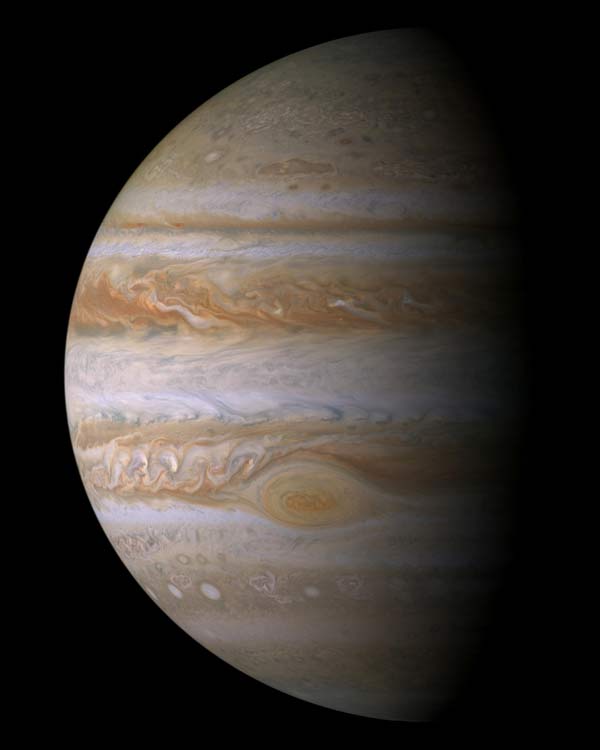
Other significant facts about Jupiter include its system of more than 65 moons and its rapid period of rotation. One day at the top of the cloud layer is only about ten hours long. The rotational velocity at this level is therefore much greater than it is at the surface of the much smaller Earth. This rapid rotation helps to produce the slightly flattened shape of the planet and its huge magnetic field, and also the tremendous storm systems in the atmosphere.
The dramatic difference in the bulk composition of Jupiter from the inner planets we have already examined is expressed in the nature of its churning interior. The internal structure of Jupiter may appear as depicted in Figure 9.2. A small, solid core, composed of water ice and rocky materials (mostly silicate minerals and iron) is shown at the center. This core is probably several times larger in diameter than our own planet. The core is surrounded by a 30,000- to 40,000-km-thick layer of hydrogen, in a liquid metallic state (H+) because of the high pressures. When combined with Jupiter's rotation, convective motions in this layer of ionized hydrogen may create the tremendously powerful magnetic field around the planet. Another layer of molecular hydrogen (H2) 14,000 to 20,000 km thick makes up the outer shell of the planet. Thus, Jupiter really has no solid surface---only a gradual transition zone between liquid and gaseous hydrogen. The brightly banded "surface" seen from Earth and photographed by spacecraft is actually the top of a thick cloud layer, composed mostly of crystals of ammonia ice. Although hydrogen is the most abundant gas (over 80 percent by mass), helium (about 18 percent) and small amounts of water, methane, ammonia, and various carbon-hydrogen compounds have also been detected in the atmosphere. The processes on such a planet are drastically different from those previously considered. No surficial geologic structures exist; since there is no crust, no impact craters, no volcanoes, or other geologic features can be produced.

Observable features are dramatic if ephemeral, and the images returned of Jupiter are among the most beautiful of any taken during the exploration of space (Figure 9.1). The light, delicately colored bands in the atmospheres are called zones; the dark bands are called belts. These semipermanent structures are similar to terrestrial cyclones and anticyclones, masses of rising and falling air produced by the circulation of Earth's atmosphere. On Jupiter these cloud patterns are stretched into thin belts by high-velocity winds. Other visible features include loops, streaks, plumes, and (most notably) spots; these are the result of shearing between the opposing wind directions of each band. The best known is called the Great Red Spot; it varies in appearance but is a relatively permanent group of storms, a cyclonic disturbance like a terrestrial hurricane. There is at least one other such feature that is invisible from Earth. It is much smaller than the Red Spot, and lies in the northern hemisphere.
Although the 1979 Voyager mission had many highlights, one of its more important results was the discovery of rings around Jupiter that is similar to, but much smaller than, the familiar rings of Saturn (Figure 9.3). The rings lie in Jupiter's equatorial plane and are almost 6000 km wide and banded like Saturn's. Since they are so thin and dark, it was not discovered through telescopes on Earth. The ring probably consists of a swarm of micron-sized particles of silicate dust or dirty ice. The outer margin is sharp, whereas the inner margin grades imperceptibly toward the planet's atmosphere. Apparently, some material from the rings spirals inward to the planet because of changes in the magnetic field or the slight pressure of sunlight.
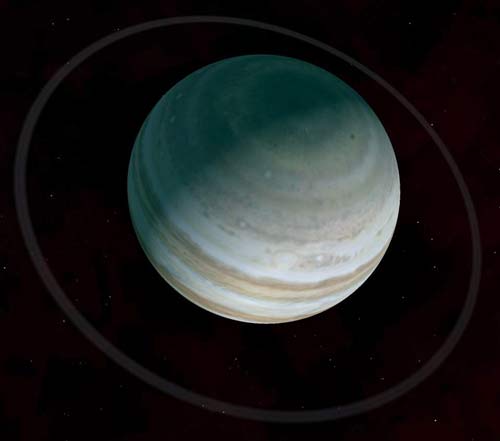
Many of the ring particles may be formed by collisions on two small satellites Adrastea and Metis, which lie near the outer edge of the ring. These satellites are nearly co-orbital, meaning they share the same orbit. Both satellites are dark and small, with diameters of a few tens of kilometers. Collisions and sputtering at the surface of these bodies may send showers of small particles spiraling inward to Jupiter's atmosphere. (Sputtering refers to the ejection of atoms from rocks or regolith exposed at the surface of an airless planet. Ejection is caused by the impact of solar wind ions on the surface.) If this is the case, then the ring is being continually or episodically regenerated by new surges of material that gradually drain into Jupiter's gravitational well. Other small moons are the sources of particles in the thin rings outside of the main ring. They are so tenuous and delicate and thin, they are called the Gossamer Rings. The origin, evolution, and implications of planetary ring systems are discussed in Chapter 10.
The photographs of Jupiter and its moons reveal a wide range of differences between the planetary bodies of the outer and inner solar system and unmask four new worlds for geologic exploration. The Galilean moons (the four large moons of Jupiter discovered by Galileo in 1610), previously known as little more than specks of light in a telescopic field of view, have now been photographed with resolution sufficient to show objects as small as ~10-20 meters across in the best images. Spacecraft cameras have found that these moons are not only complex, but are strikingly different, with their surfaces varying greatly in age, composition, appearance, and history (Figure 9.4). In order outward from Jupiter, the Galilean moons are Io, Europa, Ganymede, and Callisto. We will focus our attention on these four fascinating bodies, each unique and totally different from the planetary bodies of the inner solar system. Table 9.1 compares the four moons in terms of their basic physical properties. Their sizes are similar to terrestrial planets, but their formation in the icy outer solar system and their relationship to Jupiter have produced decidedly nonterrestrial geologic features and unique, fascinating histories. No samples have been returned from the satellites of Jupiter, their surfaces are incompletely photographed, and the best of the images have resolutions of only a few hundred meters. Thus it is not surprising that geologists have not yet agreed upon interpretations of many features observed on these moons, or upon their histories. Usually, we have tried to present what is the most reasonable explanation at the moment. Alternative explanations are discussed as well, demonstrating that the progress of science involves gathering observations and formulating hypotheses, sometimes multiple ones, followed by further testing with new observations. Clearly exploration of the moons of Jupiter will not only provide an exciting new understanding about the Jupiter system but, through comparative planetology, new insight into our own planet.
| TABLE 9.1 | |||
| Charcateristics of the Major Satellites | |||
| Satellite | Diameter (km) | Density (g/cm3) | Surface Composition |
| Io | 3,630 | 3.53 | Silicates and sulfur |
| Europa | 3,122 | 3.0 | Water Ice |
| Ganymede | 5,268 | 1.94 | Water Ice |
| Callisto | 4,820 | 1.83 | Water Ice |
| Earth's Moon | 3,500 | 3.3 | Silicates |

Io, the innermost of the Galilean satellites, has intrigued astronomers for years because of its perplexing physical properties. Its yellowish color was reported near the turn of the century. Occasionally, it shows brightness variations visible with telescopes. Spectral studies suggest that its surface is covered by sulfur compounds and that water ice is extremely rare. The satellite is surrounded by a very thin "nebula," not really an atmosphere, which has a yellow glow characteristic of sodium. It also contains the volatile elements sulfur, oxygen, and potassium, apparently ejected from the surface of Io by the solar wind. All these peculiar properties increased the desire of many to see pictures of its surface and attempt to decipher these puzzles. The trajectory of Voyager 1 allowed a very close encounter with Io and many images with resolution of about 600 m were obtained. As it turns out, the exploration of Io was one of the most spectacular and significant results of the Voyager mission.

As can be seen in the global views of Io (Figures 9.5 and 9.6), the planet is unlike anything yet examined in the solar system, although it is similar in size and density to the Moon. The surface displays a variety of pastel shades of yellow with hints of orange, mottled with irregular patches of white, gray, and black. The first impression one receives is that the surface color is a mass of confused splotches, but upon closer examination one finds some degree of order. Io's equatorial region is bright and has large irregular patches of white whereas the midlatitude regions are darker, and the poles are covered with a bluish frost. Many small dark spots are scattered across the surface, giving the planet its distinctive character. At first, the dark spots were thought to be impact craters but images of higher resolution revealed that the dark pits and markings bear little resemblance to impact craters. Unlike the Moon, Mercury, Mars, or even the Earth, no impact craters have been identified on Io. The complete absence of impact craters shows that Io is being continually resurfaced by erosion and/or deposition and that all of the features we now see are probably less than one million years old.
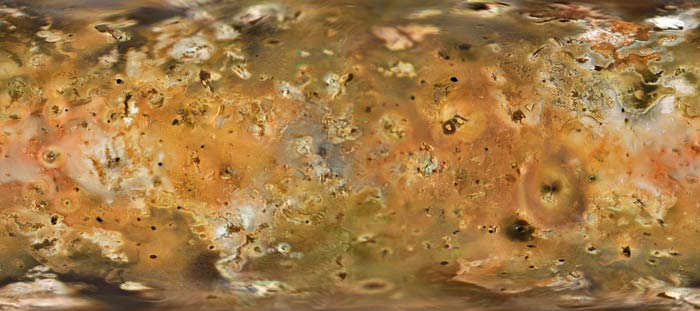
Volcanic Features. Close inspection of high-resolution images shows that the surface of Io is dominated by volcanic features. Indeed, Io is believed to be the most volcanically active body in the solar system. The volcanic features identified include volcanic pit craters, larger calderas, lava flows, low domes, a variety of shield volcanoes, volcanic ash plains, plus deposits of sulfur and other volatile materials. The principal volcanic features include over 200 calderas. These irregular pits may be as large as 200 km across and are in many ways similar to the large calderas related to ash-flow shields on the Earth's continents. Most calderas do not appear to cap high volcanic structures as they do on the lava shields of Mars and they may represent a fundamentally different type of eruption mechanism. Commonly, the calderas are surrounded by diffuse halos or by a variety of bright and dark patterns. Some calderas do have complex radiating volcanic flows that extend from the vent area in a sinuous pattern. The lava flows associated with about half of the calderas are long, narrow flows with a variety of colors ranging from black to yellow and brown (Figure 9.7). In general, they look like some basaltic lava flows on Hawaii. By terrestrial standards, however, the flows are very large with lengths of several hundred kilometers and widths of several tens of kilometers being very common.
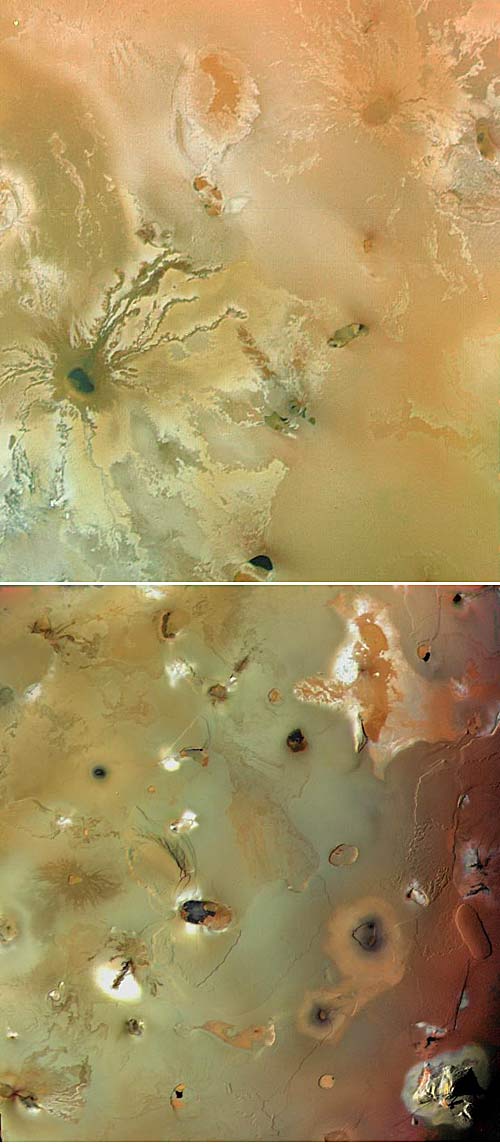
One of the most spectacular results of the Voyager mission was the discovery of active volcanic eruptions on Io. At least nine volcanoes in the throes of violent eruption were photographed during the brief encounters. These were identified by plumes of eruptive material seen against the black sky on Io's horizon, and by large brilliant flares seen in the twilight zone (Figure 9.8). If a spacecraft were to pass Earth, even with all of its volcanoes, it is unlikely that even one would be experiencing an eruption of the magnitude of those seen on Io. In addition to the nine actively erupting volcanoes photographed by Voyager, eleven volcanoes showed signs of very recent eruptions in the form of a series of diffuse rings surrounding the dark centers of eruption. Later images taken by Galileo found ongoing eruptions of some of these volcanoes and also discovered new ones. All indications are that Io is the most thermally active body in the solar system and must have many large subsurface magma reservoirs.
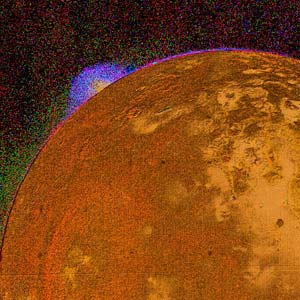
The volcanic eruptions on Io appeared as enormous umbrella-shaped plumes spraying material approximately 300 km above the surface and measuring 1000 km across. These are enormous eruptions. The internal structure of the ejecta plume was revealed by ultraviolet light, in which zones of ejected gases and fine-grained pyroclastic material extend far beyond a central region of coarse fragmented material (Figure 9.8). The morphology of the sprays of ejected material from the various volcanoes is quite variable. Besides the umbrella-shaped plumes, some ejecta is thrown out in jetlike streaks erupting from fissures up to 225 km long. Other eruption plumes were diffuse with no well-defined central fountain. It is interesting that significant changes in one volcanic spray were detected within a 5 1/2-hour period, suggesting fluctuation in the eruptive energy during that time.
The geometry of the ejecta plumes is related to the type of eruption. Jetlike streaks are probably fragmented material erupted from fissures. Umbrellalike plumes develop from central vents, with the outer plumes, which are detected only by ultraviolet light, being volatile material. The gas may consist predominantly of sulfur or sulfur compounds such as H2S and SO4 (sulfur compounds are common in terrestrial volcanic gases as well). On reaching the surface these volatile gases become so cold that a fraction rapidly condenses into fine, solid particles, which fall back to the surface as a film that mantles older volcanic deposits. Prominent bright rings surround some calderas, and it has been suggested that they consist of a thin coating of sulfur and other salts produced in this fashion. So much sulfur is released from Io's interior by this process that it has created an extremely thin atmosphere that eventually escapes into space and creates a doughnut-shaped ring, or torus, that encircles Jupiter, through which Io orbits. It is very possible that Io's surface is composed predominantly of sulfur and sulfur compounds ejected from the volcanoes. Even its magmas might be liquid sulfur, not the compounds of silicon and oxygen typical of terrestrial and even lunar rocks.
Large, explosive eruptions like those observed on Io often produce ash flows that consist of a dense cloud of volcanic ash or dust that rushes away from the center of eruption. These ash flows are very mobile and produce thin, sheetlike deposits in an apron around the volcano. Individual flows may be hundreds of kilometers long and over 10 km wide. Perhaps the colored halos (Figure 9.9) around some calderas are ash-flow sheets, not lava flows erupted from quieter volcanoes. Calderas often result from explosive ash eruptions, as large magma chambers are rapidly emptied. As a result, the roofs collapse, filling the voids created by eruption. The surrounding plains may also consist of successions of ash flows.
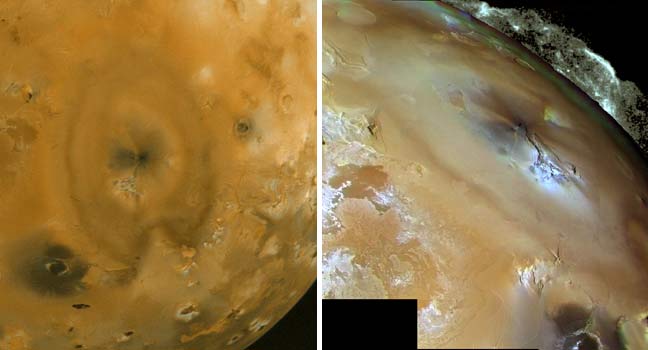
The vast tracts of smooth plains between the volcanoes are called intervent plains. These plains are composed of visible layers, the margins of which are marked by a variety of irregular scarps and unusually uniform relief. Some scarps are flow fronts; others are irregular and jagged, suggesting that scarp retreat is caused by some erosion process. Others are obviously fault scarps, which mark the margins of relatively long, straight, narrow grabens.
Unlike the other Galilean satellites, Io has no water; but studies of Io's spectral reflectance (color) suggest a variety of sulfur-rich materials at the surface. Sulfur is a complex substance occurring in many vividly colored forms including reds, yellows, browns, and blacks, probably accounting for Io's dramatic coloration.
Tectonic Features. The undeniable presence of active volcanism on Io proves that high temperatures exist within the planet---its heat engine is still alive. This thermal energy may drive an active tectonic system. Geologic evidence that this is the case is found in the photos of its surface (Figure 9.10). Many plains units are cut by scarps that resemble faults produced by tension in the lithosphere. Although there are no apparent linear chains of volcanoes or fold belts, there are irregular isolated mountains in the polar regions and large plateaus bounded by faults---suggesting that the outer rigid shell of Io is fracturing in response to motions within a fluid substratum. Most movements appear to be vertical with little or no lateral movement occurring. From these observations it is inferred that although there is active tectonism, there is no system of integrated plate tectonics on Io that could form folded mountain belts or subduction zones like those on Earth. Like the Earth's Moon, Io appears to have only one planetwide lithospheric plate.
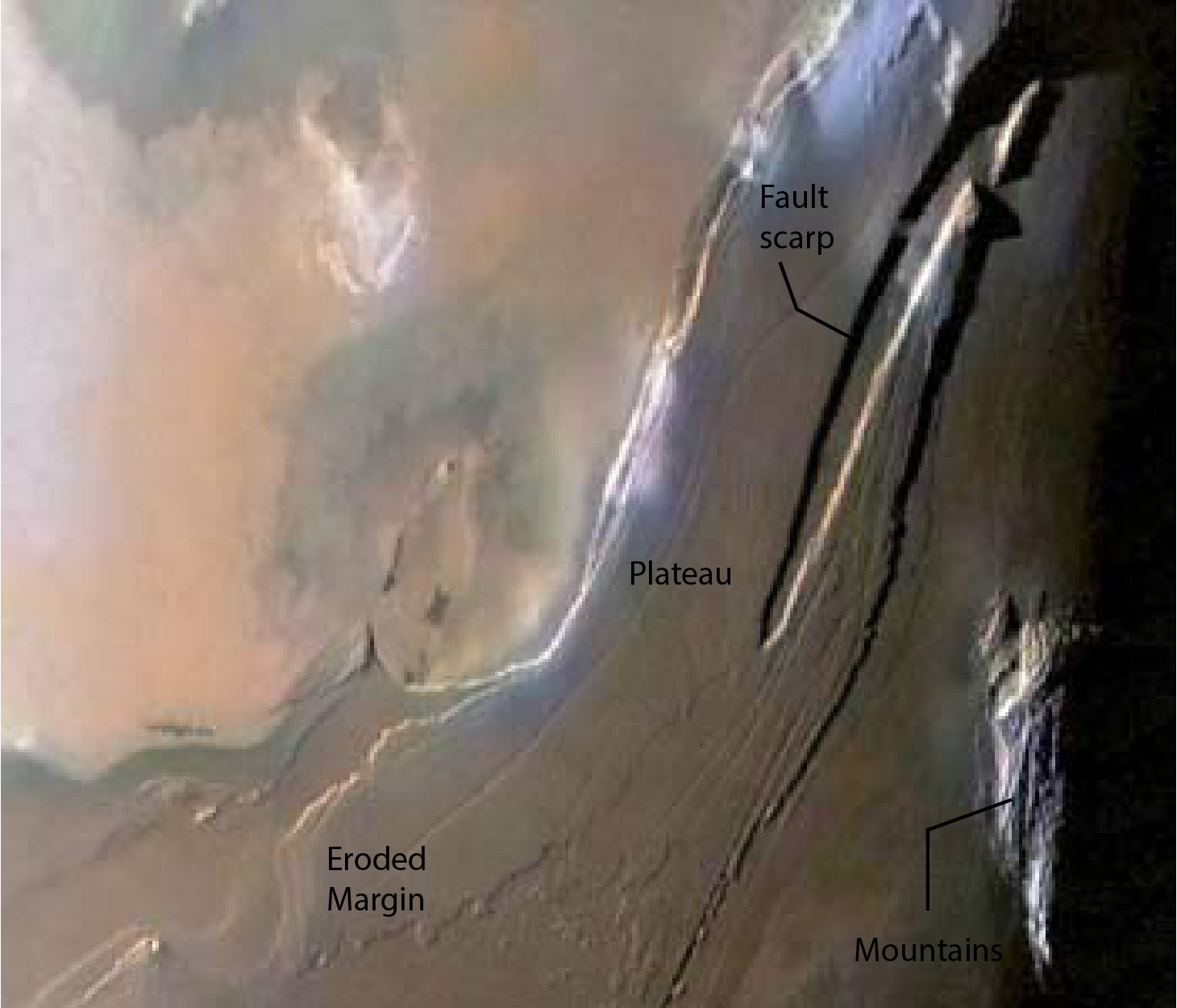
Rugged mountainous areas are also scattered across the surface of Io (Figure 9.11). These isolated massifs attain heights of almost 10 km above the surrounding plains. Most of these mountainous regions are disrupted along many linear traces, presumably faults, and have sinuous spines whose flanks almost look gullied. In a few instances, faulted, sloping segments of the intervent plains form ramparts around the mountains. Some mountains are also the sites of volcanic pit craters. The presence of high mountains on Io suggests the presence of strong silicate rocks within its crust. Sulfur is not strong enough to support topographic variations of this size; on Io, it begins to deform under its own weight when accumulations are only about 2 km thick. Thus, aside from their importance as indicators of tectonism, the mountains of Io provide convincing evidence for silicate materials and silicate volcanism at Io's surface.
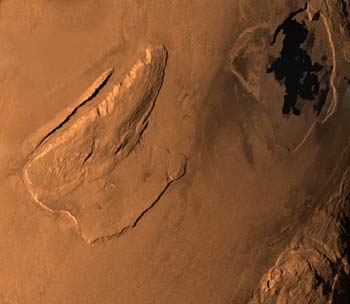
Impact Features and Surface Ages. The principal surface feature on most of the planetary bodies of our solar system is the impact crater. We have seen how they are formed and their endless geomorphic variation from planet to planet. Although most craters were formed billions of years ago, even Earth with its active geologic systems retains evidence of past encounters with large meteorites; Io does not. This stands out in marked contrast to all other planetary bodies in the solar system and clearly indicates that Io has an extremely young and dynamic surface. Although in distant views Io's volcanic calderas resemble impact craters, in detail they are very different. The calderas have irregular outlines; few are circular or polygonal like impact craters. They also lack raised rims and the textured ejecta blankets typical of lunar craters, and none of Io's volcanic craters have raised central peaks. At the resolution of some pictures, impact craters as small as one or two kilometers across would be visible if they were present, but none have been found. From comparisons of crater production rates on the more extensively studied inner planets, it seems likely that a crater larger than 10 km in diameter would be produced on Io every few million years. Apparently any craters that form are rapidly erased or modified beyond recognition. Impact craters that formed on Io have probably been buried by the extensive volcanic deposits obvious in the photos. Calculations based on the impact rates on other planetary bodies in the solar system indicate that Io is being resurfaced at the rate of one meter per 1000 years.
It is also possible to calculate the rate of resurfacing from the number and size of observed eruptions. Each eruptive center is extruding about 1000 tons of material a second, or 100 billion tons per year. This would amount to an average of 10 meters of material deposited over the entire surface of Io in one million years. This figure is comparable to the erosional stripping rate calculated for the Earth---60 meters per million years. The surface of Io is thus one of the youngest and most dynamic in the solar system.
Although there is no liquid water, or even winds generated in a thick atmosphere, there is an erosive process on Io; a process unfamiliar to us operates over the surface, stripping away some craters and volcanic deposits to create an exotic etched terrain. In the central part of Figure 9.12, a long mesa appears to have been produced by scarp retreat. The sublimation of various volatile species of sulfur may cause this, sculpting a terrain like the thermokarst terrains on Mars. Perhaps it is the intense radiation associated with Jupiter and its magnetic field that induces the escape of some molecules that make up the surface. In any case, Io is being actively resurfaced, most intensely by a veneer of young volcanic deposits.
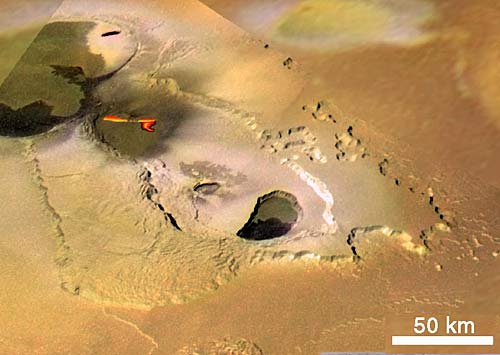
Dynamics and Internal Structure. The geologic development of a planet is largely decided by its composition, its size, and the energy available within it. Io has a density of about 3.5 g/cm3, almost the same as the Moon. This density is consistent with the speculation that Io consists mostly of silicate minerals, like the Moon. Io is also similar to Earth's Moon in its size (Table 9.1). Yet, 4.6 billion years after its formation, when other bodies of comparable size have cooled and become geologically dormant, it still has enough internal energy to melt and eject tons of material through numerous volcanoes on its surface. To keep a silicate-rich body the size of Io warm enough to remain partially molten for this length of time requires an unreasonably large proportion of radioactive elements as an internal energy source. It is more likely that the energy that heats Io is from an external source. Earlier, we discussed how tides can be raised in a satellite's lithosphere by the gravitational attraction of its primary. This effect has caused Io and the other Galilean satellites to rotate synchronously with their orbital periods; they thus keep the same hemisphere pointed toward Jupiter (as the Moon does toward Earth). If this were the whole story, any tidal bulge created by Io's attraction to Jupiter should always be in the same place, not allowed to relax and heat the satellite. However, Io's orbit is eccentric (not perfectly circular); thus, variations in the Jupiter-Io distance, and consequently tidal strain, occur. The eccentricity is caused by gravitational interactions in the satellite system. Io, Europa, and Ganymede have achieved orbital resonance---that is, their orbital periods are simple multiples of one another. In this case, for each orbit Ganymede makes around Jupiter, Europa makes two, and Io four. This resonance forces Io to have a slightly eccentric orbit, causing the distance between Jupiter and Io to change, and thereby changing the height of the tidal bulge. As the energy from these changes is dissipated, heat is produced, which apparently melts the inner regions of Io and provides abundant magma. This external heating mechanism is a relatively permanent energy source for such a small body and may keep Io thermally active long after the Earth, with its radioactive heat engine, has cooled and become geologically dormant.
Because of this unusual energy source, the internal structure of Io may be unique. When the effects of the extraordinary mechanical heat engine and heating from its own radioactive elements are compounded, it is very likely that Io is extremely differentiated and has experienced extensive outgassing of volatile elements. After its accretion, whatever water (H2O) and carbon dioxide (CO2) existed in the planet were probably rapidly released as the planet heated and have since escaped, because of Io's small mass and low gravitational field, leaving a volatile-poor planet. Sulfur, which is also fairly volatile, may condense rapidly from these emissions and return to accumulate at the surface.
Since Io is continuously heated, a thick lithosphere has never formed. It may be as thin as 20 km and rest atop an ocean of silicate magma. One idea for Io's structure is shown in Figure 9.13. A thin, solid crust of sulfur and sulfur compounds is underlain by a layer of silicate rock. Beneath the solid silicate layer a much thicker body of partially molten or convecting silicates probably exists that may extend to the core. From its assumed composition, density, and high internal temperatures, Io's core probably is composed of molten iron, but it lacks a magnetic field. Intrusions of silicate magmas onto the sulfur rich crust may produce violent explosions that penetrate the crust and produce sulfur and silicate volcanoes--most likely basaltic in composition.
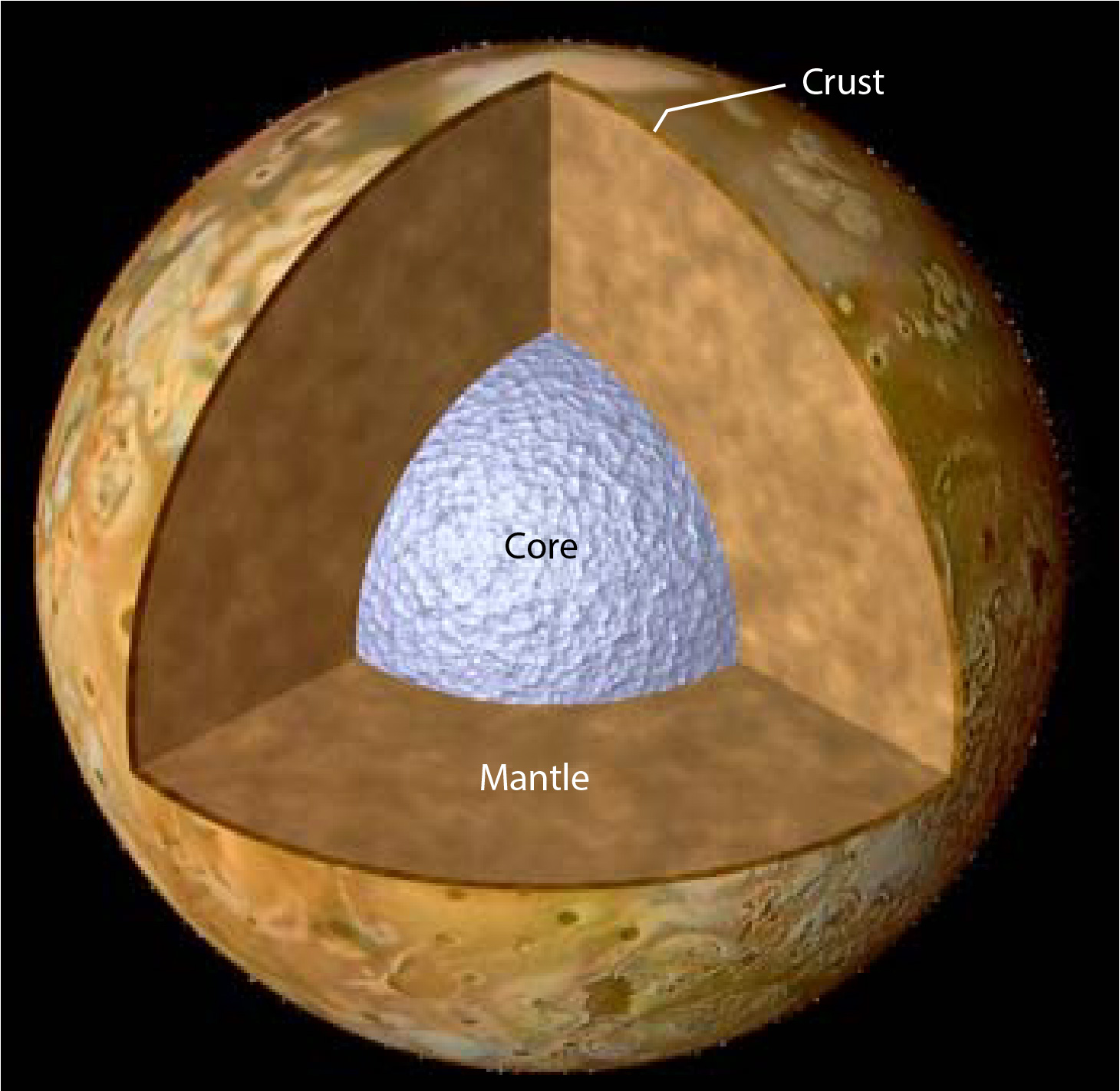
The high internal temperatures that have existed inside Io for billions of years may have allowed extensive differentiation into shells of distinctive density and composition. Lateral density differences may not be pronounced now; as a result, lithospheric plates do not appear to be consumed by subduction. Rather, a continuous vertical recycling of lithospheric material may exist. As magmas are poured onto the surface, building a new crustal layer, the underlying layer is depressed, melts at the base through a type of thermal erosion, and begins a new path toward the surface. This style of vertical cycling is reminiscent of that proposed by some for Venus and the early Earth. Such a process active for so long would have allowed very extensive chemical differentiation of the satellite.
From the facts in hand, we can speculate about Io's geologic development. Io probably accreted from a cloud of debris circling Jupiter about 4.5 billion years ago, incorporating its own complement of radioactive elements, water, carbon dioxide, and sulfur. Early melting of the small moon probably occurred, just as on Earth's own Moon, but was driven in part by tidal heat from its interaction with Jupiter, and also radiogenic and accretionary heat. This melting was probably more extensive and occurred more rapidly on Io than on the Moon because of the extra energy source, and resulted in a molten core (sulfur- and iron-rich), a magnesium-silicate mantle, and a lighter silicate crust. (It has been suggested that Io's core is composed of iron oxides, instead of iron or iron sulfides. Sulfur not extracted to the core would become enriched in its outer layers and available for volcanic outgassing.) By analogy with the Moon and taking into account Io's larger heat production, differentiation probably occurred during intense bombardment, and many craters that formed during this period were probably short-lived. Although Io degassed large amounts of volatiles, nitrogen, water, and carbon dioxide were rapidly lost to space because of Io's intrinsically low gravitational attraction and their volcanic ejection to high altitudes, where the gas interacts with Jupiter's magnetosphere. Gradually, a sulfur concentration was built up on the surface as it condensed rapidly in cold space, while the interior of the planet became volatile-depleted.
Continuously heated from an external source, volcanism has been a persistent process. Repeated melting and differentiation at the base of the silicate lithosphere may have eliminated all lateral density contrasts in this thin, rigid zone, allowing vertical movements and continuous recycling of light silicate materials to dominate the recycling of lithospheric material. Of course the sulfur-rich veneer thickened and may have become tens of kilometers thick (depending on how much sulfur Io had originally and how much was sequestered in its core). Since sulfur has a lower melting point than most silicate minerals, once it became thick enough, it could form an "ocean" of molten sulfur above the silicate lithosphere with its own cap of solid sulfur-rich materials. In some ways this is analogous to the situation at Earth's north pole, where ice floats atop liquid water and covers a silicate-rich lithosphere. The shell of sulfur-rich materials, if it really exists, could be called a thiosphere (thio in Greek means sulfur) analogous to the hydrospheres (water-rich), cryospheres (ice-rich), and lithospheres (rock-rich) of other planetary bodies that are not as extensively differentiated. In this regard, Io may be one of the most chemically fascinating bodies in the solar system.
Europa is the next satellite out from Io. Europa is only slightly smaller and less dense (~3.00 g/cm3) than Io. Models of its condensation history and chemical composition suggest that Europa accreted from material richer in water, making it less dense than Io. This water appears to have been released during differentiation to form an icy mantle surrounding a silicate core. Telescopic observations of Europa's spectral characteristics confirm that water ice is exposed on its surface.
The surface of Europa resembles a fractured ice pack in the Arctic Ocean (Figure 9.14). The maximum relief on Europa is about 1000 m, in contrast to features that rise from 4000 to 9000 m on Io. This low relief suggests that the subsurface material is partly liquid and slushy, so that isostatic adjustment of the ice prohibits the development of high landforms. It is uncertain if silicate materials are exposed at the surface at all.
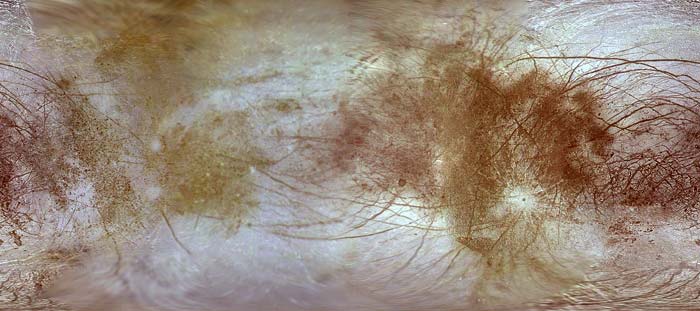
There are two major terrains on Europa: plains and mottled terrain (Figure 9.15). The bright plains appear to be the older of the two terrains and are crossed by a distinctive set of narrow bands or stripes. The mottled terrain, also cut by these features, has a much rougher, pitted topography and is darker than the plains. Craters are rare, but a variety of fractures and ridges distinguish Europa from its Jovian companions.
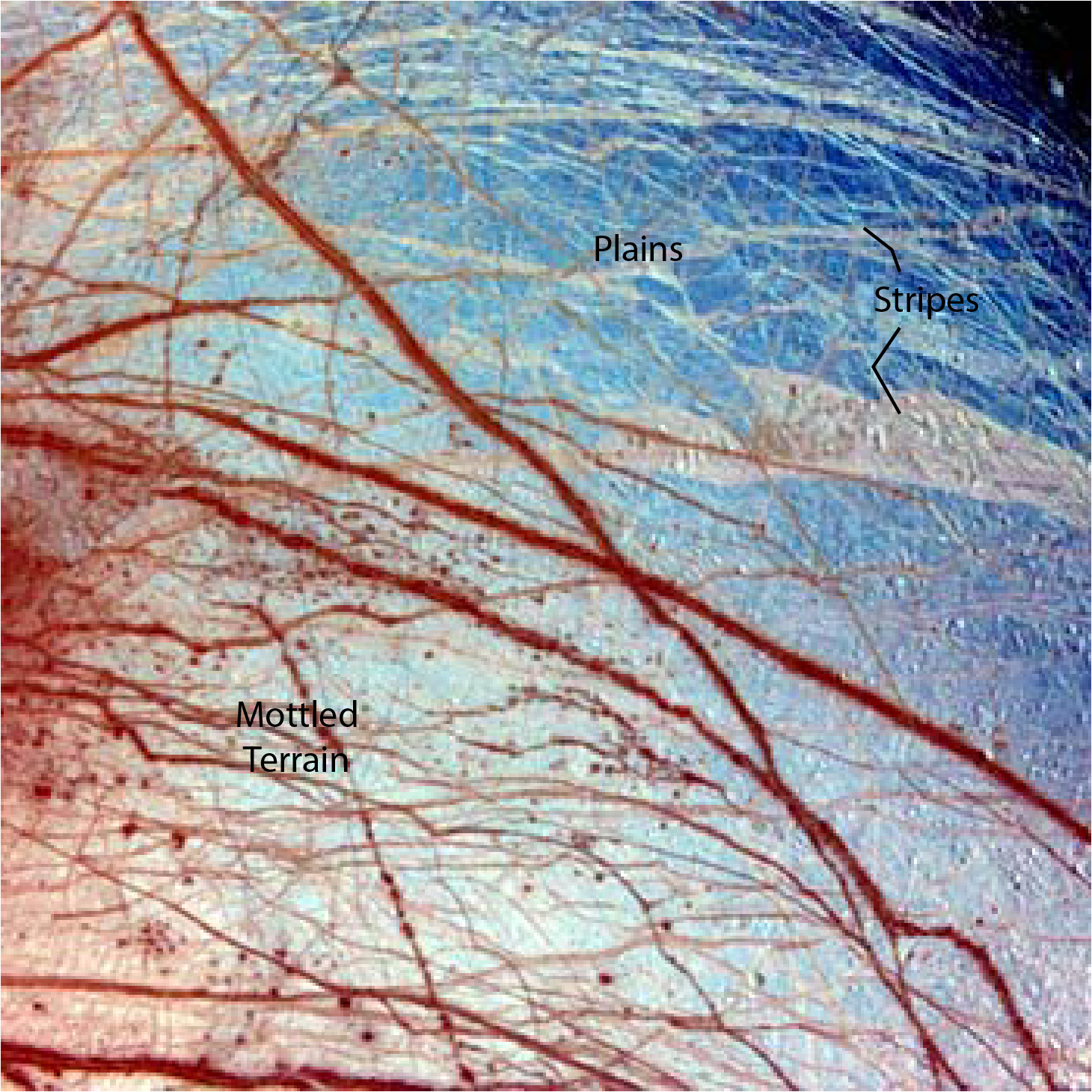
Craters. Like Io, the surface of Europa is also distinctive in that its surface is essentially uncratered. Photos of neighboring Callisto and Ganymede at a resolution similar to that in Figure 9.15 would show many craters between 50 and 100 km in diameter, whereas on Europa there are none. The surface of Europa is completely younger than the period of intense bombardment and must also be younger than the grooved terrain on Ganymede (described in a later section). The key question is how much younger. The lack of numerous craters indicates that internal geologic processes are still modifying its surface. Based on impact crater production rates on the inner planets, the bright plains may be only several hundred million years old.
Careful studies of all the photographs of Europa taken by the Voyager and Galileo spacecrafts only found a few fresh craters 10 to 30 km in diameter. Pwyll crater (Figure 9.16) is surrounded by a system of bright rays and is marked by a central peak. However, the crater is very shallow, as if fluid ice flowed upward to erase it by isostatic adjustment. Such craters are called palimpsests, a Greek term that refers to parchment that has been scraped clean to allow further writing; usually the erasure is not complete and the earlier writing can still be seen.
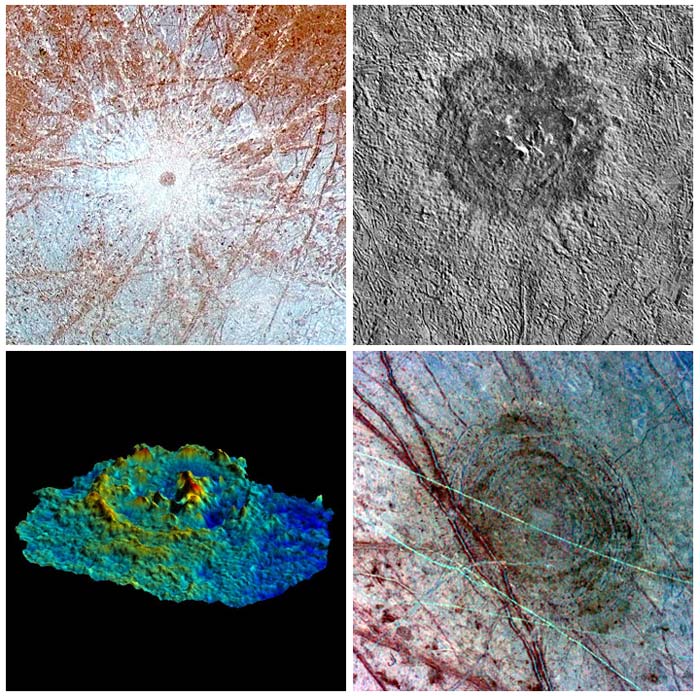
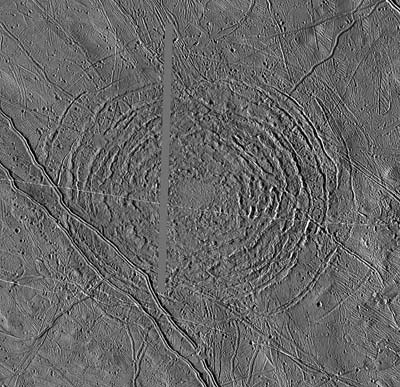
There is also a small multiring crater with several concentric rims and troughs (Figure 9.17). Tyre is a small multiring feature, but it lacks a deep topographic basin. It is a dark circular spot near the center of some large regional fracture patterns. Other similar dark patches with nearly radial lineation patterns appear on the global mosaic (Figure 9.14) and are suspected to be crater scars. If this is the case, impacts occurring sporadically across Europa's surface may have developed zones of weakness in the crust, which influenced structural patterns of fractures and ridges.
Tectonic Features. The most spectacular feature on Europa is the intricate network of streaks that extend across the surface in various directions. These are thought to be fractures in Europa's crust filled by ice and slush from below to form dikelike structures---a type of icy-fissure eruption. Some fractures range up to several thousand km long and 70 km wide. Although some have been called dark and appear brown on the color-enhanced images, they are in fact gray against the white of Europa's plain's surface.
The fracture systems of Europa may be subdivided into sets that apparently have different structural origins. Some are global in extent, whereas others are restricted to local areas. Some are straight, others curved. Some form thin, sharp lines, whereas others are faint broad swaths. All, however, appear to be fractures and present a pattern similar to pack ice in the Earth's polar regions fractured by repeated breakups.
Dark Wedge-Shaped Bands. Dark wedge-shaped bands form the most conspicuous fracture systems on Europa. These coarse, dark fractures extend across the equatorial region in a general southeasterly direction (Figure 9.18). They are among the widest fractures on Europa but taper rapidly and ultimately pinch out. The margins are sharp, and the material filling a fracture is darker, so the wedge shape is quite distinct. This wedge shape and the apparent displacement of some crossing lineations suggest that expansion and rotation of blocks of the preexisting crust was involved in their formation. This suggests that a form of plate tectonics and strike-slip faulting may be responsible for Europa's crustal deformation. Slight rotation of the crustal plates opened gaps into which the warmer icy slush mixed with rocky material and was injected to form a small stripe of new crustal material.
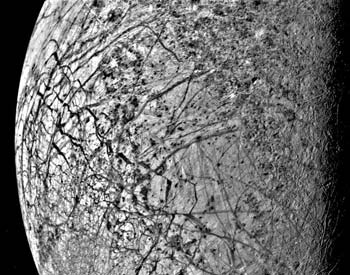
Triple Bands. Triple bands constitute the second most conspicuous fracture type on Europa. These consist of fractures filled with dark material along their margins, with narrow stripes of bright material running down the center (Figure 9.19). Occasionally, the central stripe is a ridge. The triple bands commonly merge with a single brown streak, suggesting that many faint lineations may be unresolvable triple bands. This fracture system is global in extent and contains some of the longest fractures in Europa. Crosscutting relations show that parts of some triple bands are older than some fracture systems, whereas other parts are younger. This observation shows that the stress fields forming the global system existed over an extended period of time and must have had diverse orientations.

Generally, the triple bands disappear when traced into the brown, mottled terrain, suggesting that they are older and were obliterated when the mottled terrain was formed, or that the physical properties of the mottled terrain are sufficiently different from the plains to prevent fractures of this type from forming.
The triple band fracture system is believed to have formed because of global expansion. Zones of weakness induced by tidal stress may have guided the bands' orientations. The resulting fractures were filled by slush and water from below, perhaps containing rocky material. This intrusion formed a dark dike of new crust. Subsequent stress reopened the fracture, and clean water formed the bright central stripe.
Gray Bands. Gray bands occur in the southern part of Europa (Figure 9.20) and are distinctive in that they are the widest fractures on the planet. They are cut by other structural features and are thus older. Their restriction to a local area suggests that they are the result of local tectonics.
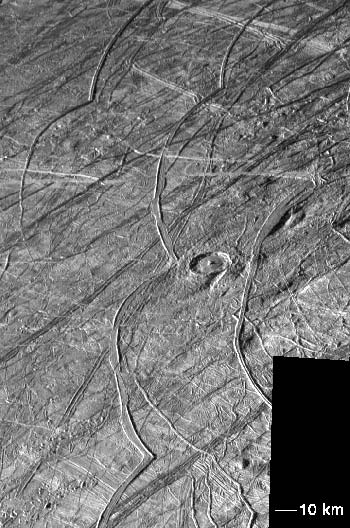
Ridges. Ridges are clearly visible only near the terminator and near the south polar region, where the low Sun angle enhances features with low topographic relief. Probably, they are present over much of Europa's surface. The most striking examples are the curved white ridges in the southern hemisphere, which can be traced near the terminator as a series of broad, graceful scallops (Figure 9.20). They are 5 to 10 km wide and rise at most only a few hundred meters above the surrounding surface. The ridges are the youngest tectonic features on Europa, as is evidenced by the fact that they cut all other features. Some ridges, however, merge with triple bands. It is probable that the ridges formed by intrusion of clean ice into fractures, much like triple bands.
Brown Spots. Besides the major terrain types (plains and mottled terrain) and the fracture system, irregular patches of brown material occur in various isolated areas. This material is similar in texture, color, and albedo to the material filling dark fractures and is especially abundant where major structural systems intersect. This material is probably the result of intrusion and extrusion of contaminated water and slush from below.
Internal Structure and Dynamics. One idea of Europa's internal structure is shown in Figure 9.21. A water-rich lithosphere (or cryosphere), possibly 100 km thick, may have formed from a vast ocean that covered the entire planet shortly after its accretion, initial differentiation, and outgassing. An alternative to this thick ice model for Europa's cryosphere is that the icy outer shell is only a few tens of kilometers thick. If this is the case, then the brown spots and mottled terrains may represent the peaks of silicate massifs nearly protruding through the icy shell. Excavation of these materials by impact or magmatism may create the dark coloration of some areas of Europa. This outer icy crust may be underlain by a watery asthenosphere over which the cryosphere may deform. Because of the absence of lateral density differences in the icy outer layers of Europa, most movements are probably vertical; subduction is not apparent. It is not known if Europa has a molten core, or a detectable magnetic field.
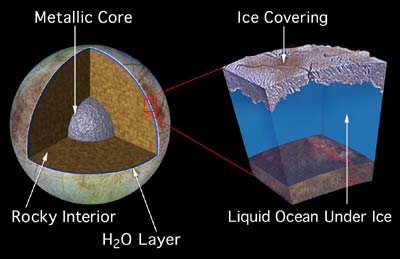
Because of Europa's small size, rapid radiative cooling might be expected to have quickly produced a thick, rigid lithosphere that could preserve many impact craters. The absence of many craters and the apparent youth of Europa's surface suggests that a small external energy input has slowed its cooling substantially and allowed thermally driven geologic processes to continue to the present, or nearly so. The tidal heating mechanism that heats Io has apparently also heated the interior of Europa, allowing repeated eruptions of watery lavas to obscure its early history. Moreover, a warm, thin layer of ice deforms much more easily than most silicate materials, by slow flowage or glacierlike creep. Hence, even if not buried by volcanism, large craters may have been relatively short-lived features, as relaxation (the slow upward flow of deep materials) tends to obliterate any depressions on the surface.
As to what created the cracks, there is no simple explanation. It is hard to imagine that they are the result of simple planetary expansion unless Europa, too, has some external energy source to keep it warm and crack its youthful surface. Possibly the tidal heating mechanism may keep Europa slightly warm, as it does Io. Alternatively, the cracks may be the result of deformation arising from within as deeper, warmer layers of ice or silicate material convect and disrupt the surface ice. Another suggestion holds that the fractures may be the result of tidal disruption of the icy crust from the constant gravitational tug-of-war going on between the satellites and Jupiter.
Just as the planets of the solar system show a regular decrease in density outward from the Sun, so do the Galilean satellites of the Jupiter system. Ganymede, the largest satellite in the solar system, is over twice as massive as Earth's Moon and has a diameter about the same as Mercury's, yet its density is only 1.9 g/cm3. The low density suggests that a substantial portion of its bulk, perhaps half, consists of water as a liquid or a solid. Thus, Ganymede, together with Callisto, represents a class of large, low-density planetary objects common in the outer solar system.
Most models of accretion and radioactive warming of these ice-rock mixtures suggest that they became differentiated as ice was melted and formed a predominantly icy mantle, or cryosphere, a liquid water asthenosphere, and a rocky core. Ganymede's outer icy shell is probably much thicker than Europa's.
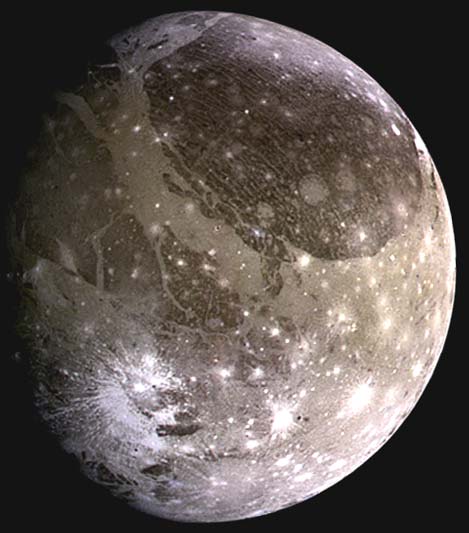
Surface Features. Viewed from a distance, the surface of Ganymede almost seems familiar and resembles in many ways the airless planetary bodies of the inner solar system---Mercury and the Moon. There are large areas with significant color and brightness contrasts (Figure 9.22). Bright, rayed impact craters as well as highly degraded rayless craters pockmark its surface and attest to its ancient age. Close inspection reveals that most of the bright regions are striated by innumerable crisscrossing grooves and have distinctly fewer craters than the darker irregular patches. Two distinct terrain types are thus distinguishable---the dark, cratered terrain and the bright, usually grooved, terrain (Figure 9.23).
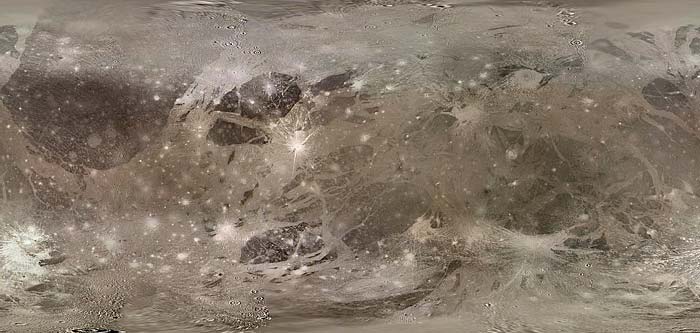
The Cratered Terrain. The cratered terrain is dark and nearly saturated with craters a few tens of kilometers in diameter, a condition similar to that found in the ancient lunar highlands, which date back to the period of heavy bombardment that ended almost 4 billion years ago. If the rate of meteorite impact was approximately the same on Ganymede as on the Moon, then these regions are about the same age and record the events of this cataclysmic era. Whatever their absolute age, the dark, cratered terrains are the oldest surfaces recognized on Ganymede. They appear to be composed of older ice, darkened by mixing with silicates from meteoritic projectiles. Spectral studies show that silicates are present at the surface of Ganymede in greater abundance than on Europa.
Most of Ganymede's impact craters are shallow, and some have broad central uplifts or small inner rings and pits (Figure 9.24). Although most of the craters are degraded and old, the fresher craters display crisp outlines and prominent ray systems. In Figure 9.25, craters with light and dark rays are prominent. Larger craters have subtle outer rings. This is especially obvious on the younger craters, which contain obvious white rings. Many areas have large circular bright spots, which may be very ancient craters almost erased by later events (Figure 9.26). Their topography might have been reduced by slow, viscous relaxation of the icy crust during Ganymede's early history. An alternate view, worthy of further consideration, suggests that ancient craters collapsed immediately after impact, this because of the low melting point of ice and the relative ease with which it deforms, compared to the silicate lithospheres that dominate the inner planets. The lack of mountainous features and large basins also suggests that viscous flow in the cryosphere may have occurred. However, remnants of large multiring impact structures are partially preserved on the old cratered terrain---fragments similar to the complete multiring structure discovered on Callisto. One, located in the Galileo Regio area (Figure 9.23), consists of an extensive system of rings expressed as narrow, regularly spaced furrows, which appear to be grabens. The furrows cover an area larger than the United States but are centered on a partially preserved palimpsest only 500 km in diameter. This ancient crater may have formed when Ganymede's icy lithosphere was very thin indeed---perhaps only about 10 km thick and barely able to preserve a crater at all---and attests to the dramatic differences in crater morphology caused by lithospheres of different thicknesses and target materials of different strengths.
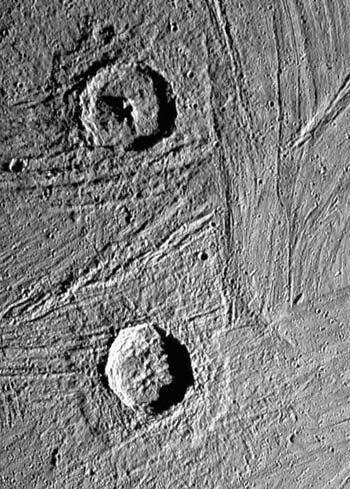
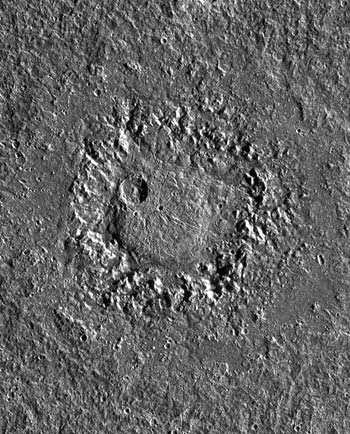
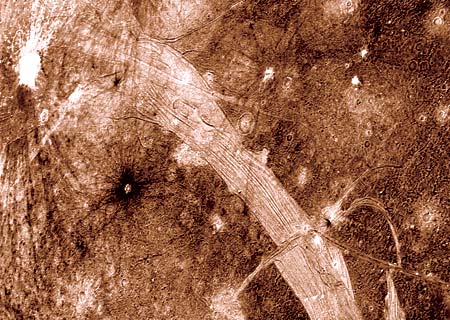
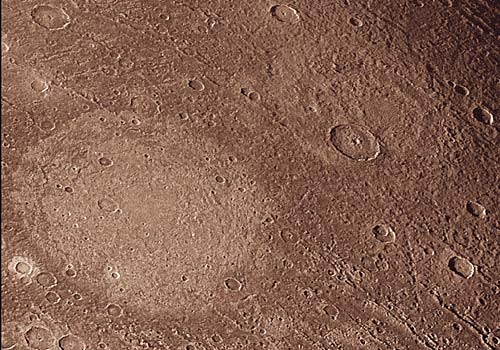
Bright and Grooved Terrains. Dividing large patches of dark, cratered terrains are broad swathes of bright, apparently younger, terrains. Some bright terrains are crisscrossed by narrow grooves. The grooved terrain is the most peculiar structure on Ganymede. Nothing quite like it has ever been observed on other planets of the solar system. In any attempt to analyze and understand it, we must remember that Ganymede has an outer shell of ice, and we may not be able to think in terms of surface and tectonic processes with which we are familiar on the terrestrial planets. As shown in Figure 9.27, the bright terrain occurs in a series of complex systems of stripes or bands, which divide the older cratered terrain into a series of isolated islands several hundred to as much as 1000 km across. A few small patches of bright, relatively smooth plains lacking grooves are found within this terrain or at its margins. Individual grooves are only a few hundred meters deep but may be hundreds of kilometers long, similar in many respects to graben. Generally they run parallel to the edge of the cratered terrain; occasionally they end against one another, are sinuous, and some are offset in faultlike fashion (Figure 9.28). Each segment of grooved terrain is a mosaic of groups or bundles of grooves, which terminate abruptly at the boundary with an adjacent system. Some systems cut across others but apparently do not displace or offset them. Some sets of grooves, however, are offset laterally as though by strike-slip faulting. They typically form curved or arcuate patterns.
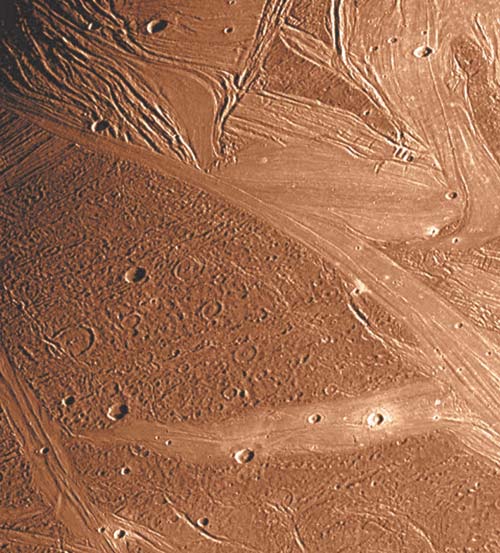
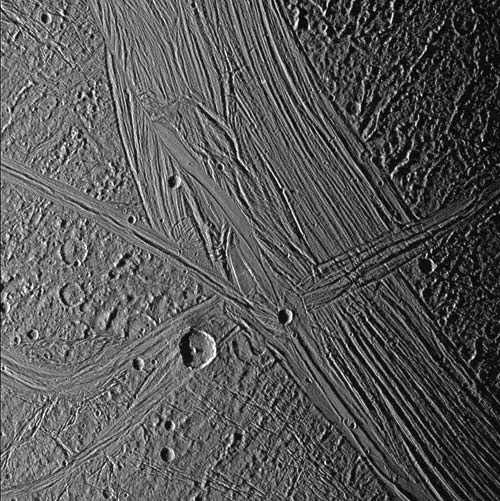
The crater frequency on Ganymede's grooved terrain varies from place to place, indicating that it developed over some period of time, but on the average the crater frequency is approximately one-tenth that of the older cratered terrain. The crater frequency of the youngest sections of the grooved terrain is about the same as that of the oldest lunar maria and the oldest martian plains, suggesting that formation of the grooved terrain ceased about 3 billion years ago, at about the same time as the extrusion of the oldest mare basalts on the Moon. Impact craters in the grooved terrain are generally deeper than their counterparts of similar size in the ancient cratered terrain. There are also few palimpsests developed in grooved terrain. These facts suggest that Ganymede had cooled substantially by the time the grooved terrain formed. As a result, the icy lithosphere was thicker, stiffer, and more able to support substantial topographic relief over millions of years.
The origin of the grooved terrain presents some perplexing problems. These stripes of bright terrain are probably not the result of impact processes but must involve some type of deformation of Ganymede's crust that accompanied total obliteration of older terrains. More than half of the ancient cratered surface appears to have been disrupted by grooved terrain---obviously the result of some process acting on a global scale. Nothing like it is seen on the terrestrial planets, and until now geologists had given little, if any, thought to the tectonic processes involving a lithosphere composed of ice. Being relatively younger and brighter than the cratered terrain, the grooved terrain is believed to be composed of relatively clean ice. Present theories consider the bright grooved terrain to have been formed rifting of previous crust followed by volcanic resurfacing, forming the bright terrains, and then fracturing to make down-dropped blocks, forming the grooves. The terrain is bright because clean ice was extruded from beneath the older cratered surface darkened by contamination with meteoritic debris. Volcanic features similar to those found on the terrestrial planets and Io, such as shields, cones, fissures, or flow fronts, have not yet been identified on Ganymede, but it is almost certain that volcanic processes helped to modify the crust. Smooth plains that occur as patches within the grooved terrain were produced by the flow, ponding, and solidification of an extremely fluid volcanic liquid, probably water (Figure 9.29). But how do these watery magmas reach the surface? Since the form of ice found at the surface of planets is less dense than the liquid, watery magmas would only rise partway to the surface and then freeze as subsurface intrusions. However, if the water contained bubbles of water vapor or other gases, liquid water "magmas" would be less dense than the surrounding ice and could rise completely to the surface and extrude as lavas. The rifting that formed these terrains may have been in response to global expansion, which resulted in the formation of dominantly normal faults that acted as avenues for the volcanic liquids.

Internal Structure and Dynamics. Ganymede's low density (1.9 g/cm3) indicates that it may contain about 50 percent by mass of dense silicate materials. Most of its bulk is made up of frozen water (Figure 9.30). During accretion, these ices and the silicates were probably well mixed, but an early differentiation event probably resulted from a combination of accretionary, radiogenic, and perhaps tidal heating. (Tidal stresses may have been much greater early in its history, before its synchronous rotation evolved.) The icy part of the planet may have melted quite rapidly, leaving the silicates and metals unmelted. The heavy metallic and rocky materials could have sunk to the center of the satellite. The rocky center further differentiated to release metallic iron (and sulfur) that drained to form a metallic core. Ganymede even has a magnetic field today, probably generated by convection in the core.The outer portion of the moon consists almost entirely of liquid water. An early liquid ocean would have gradually frozen at the low surface temperature (almost 120 K), thickening from the top down, but a salty liquid layer still persists inside Ganymede. The ancient crust became the heavily cratered terrain, dark because of meteoritic contamination. Because several forms of ice expand (rather than contract like most materials) as they freeze and cool, thickening of the icy outer rind may have resulted in slight expansion at Ganymede's surface, fracturing and faulting the cratered terrain to produce large tracts of grooved terrain. Their lighter color and fewer craters may be attributed to the eruption of younger, clean ice through the fractures. Others suggest that Ganymede expanded because of heating by radioactive decay in its silicate core. When expansion occurred is difficult to decide, but it apparently is not a recent event because of the number of craters superimposed on the grooves; some estimates place its formation at about 3.5 billion years ago. Thermal models indicate that icy Ganymede may have remained in this expanded condition without contracting as Mercury and the Moon did. Theoretically, present-day convection in a solid, icy mantle seems possible, but there is no obvious geologic evidence of young tectonic features. Aside from meteorite impact, the reduction of topographic relief by slow, viscous creep seems to be the only process active for a very long time.
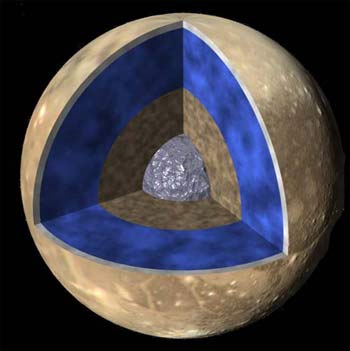
In summary, the closeup observations of Ganymede reveal a new type of icy world, different in composition and history than any of the rocky inner planets. Ganymede is probably differentiated into a metallic core, silicate mantle, and icy crust. Subsequent to a period of heavy bombardment like that experienced by the inner planets, ancient impact basins and large craters, which normally produce high topographic relief, were reduced, but not completely eliminated, by viscous flow in the icy lithosphere. Later, the crust of Ganymede experienced a period of even more dramatic change, when sections of the older cratered terrain were replaced by bright volcanic terrains and extensional faults. The development of this terrain appears to be correlated with the thickening of the icy lithosphere.
The outermost Galilean satellite is Callisto (Figure 9.31), a low-density body (1.8 g/cm3) slightly smaller (4820 km in diameter) than Ganymede. Callisto is the most heavily cratered planetary body in our solar system (Figure 9.32). Because of its densely cratered surface, it resembles the Moon, but it lacks regions of major brightness contrast like that between expansive lunar maria and the highlands. Spectral studies of Callisto show that its surface is composed of water ice. Even though it has an icey surface, Callisto is relatively dark, only about half as reflective as Ganymede (but still twice as bright as the Moon) suggesting that the surface of Callisto is dirty ice. Temperatures at the equator are a frigid 120 K.
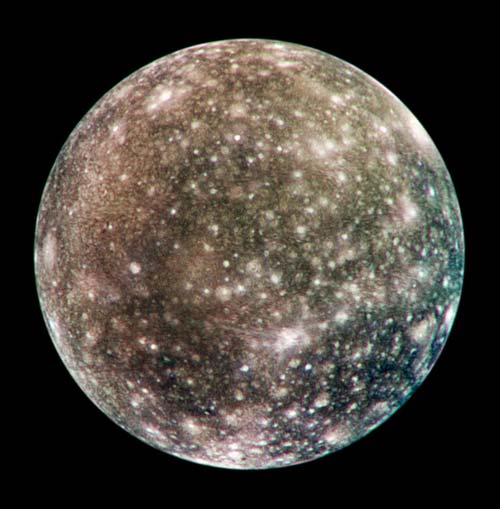
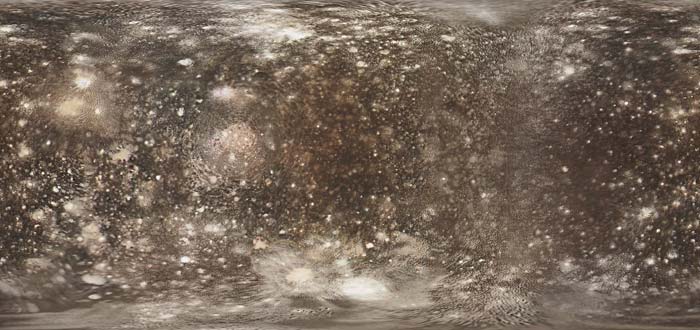
Impact Craters. Although Callisto is densely cratered, somewhat like the highland regions of Earth's Moon, it is different from the Moon in several important ways. There is a distinct paucity of craters larger than 50 km in diameter, as compared to the inner planets. The reason is not immediately obvious, but the anomalous distribution in crater size may be due to the peculiarity of the population of impacting particles in the outer solar system, or it may be due to the response of ice to impact (large craters may have been preferentially destroyed).
A glance at Figure 9.31 reveals that many craters have bright areas in their centers that are reminiscent of the central peaks in craters on the terrestrial planets. These bright areas are probably the result of clean ice melted during impact and refrozen at the surface. Many craters have central pits. The bright rims, rays, and ejecta are also believed to represent cleaner ice from the substratum, brought to the surface during the impact.
The densely cratered terrain indicates that most of the surface of Callisto is very old, probably dating from the period of intense bombardment ending about 4 billion years ago. The extreme range in the degree of preservation of the ejecta and rays indicates that the cratering process continued throughout geologic time, with the rate of cratering decreasing exponentially with time similar to the cratering histories of the terrestrial planets.
Multiring Structures. Aside from the densely cratered terrain the most striking features on Callisto are several large multiring structures (Figure 9.33). Although these features are similar in some respects to the large multiring impact basins on the Moon, Mercury, and Mars, there are several important differences. The most obvious difference is that the rings are more many and are much closer together. Just as important is the fact that there is no central basin. Concentric rings on Callisto encircle Valhalla (Figure 9.33), a bright central palimpsest about 300 km in diameter, and extend another 1000 km outward from the bright interior, like gigantic ripples. At least 25 separate rings exist; segments of some rings are continuous for about a thousand kilometers (Figure 9.34). Other multiring structures are shown in Figure 9.35. Most investigators have concluded that these ancient ring structures are the result of large impacts early in Callisto's history. Nonetheless, these are in striking contrast to the multiring impact basins on the terrestrial planets, which generally have less than five well-defined rings. In addition, the multiring basins on Callisto lack the radially textured ejecta blankets that surround basins on other bodies. Another difference on Callisto lies in the regularity of the spacing of the rings. On the inner planets the spacing increases outward from the center of the basin.
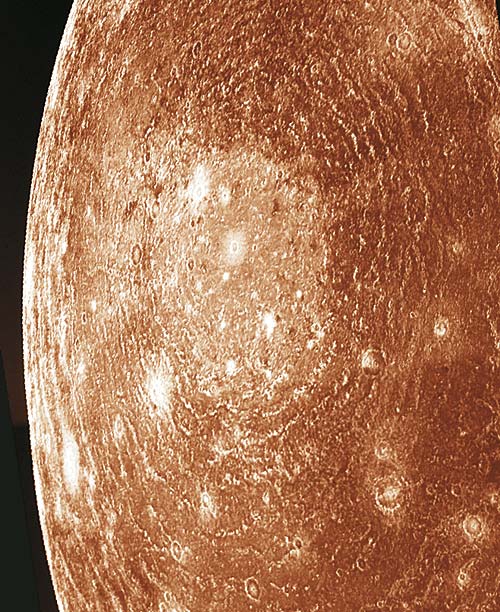
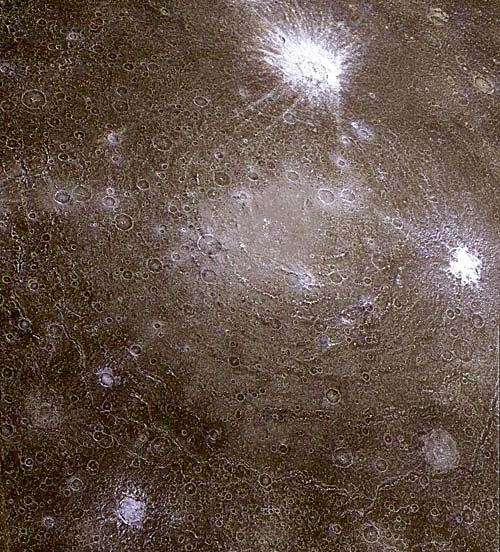
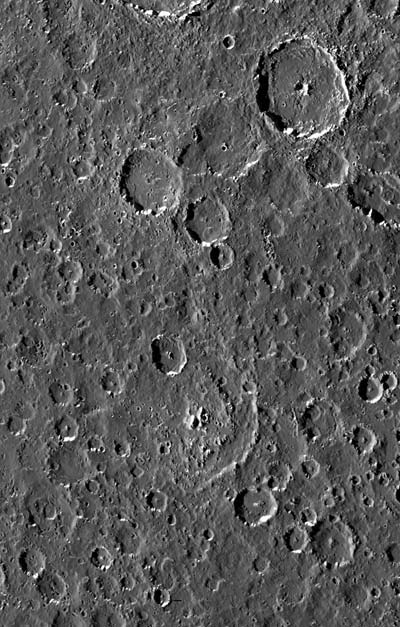
The difference between the multiring structure on Callisto and those on the terrestrial planets is probably due to the way ice responds to the impact of a large asteroid-sized body. Viscous flow would be expected in an icy crust during or subsequent to impact and would be expected to reduce the topographic relief of the basin and ringed structures, leaving only low, closely spaced ridges and a central area of high reflectivity to mark the former position of the impact basin.
Beyond Valhalla, the surface of Callisto is nearly saturated with small craters, but the central area is far less heavily cratered (Figure 9.33). The crater frequency increases from the center outward to the outer rings, where it reaches the average frequency of the surface of the satellite. These relationships imply that Valhalla was formed relatively late in the period of intense bombardment.
Internal Structure and Dynamics. Callisto's surface features suggest that its structure and evolution were significantly different from its near neighbor Ganymede. Figure 9.36 shows a possible arrangement for Callisto's interior. Since it has a lower density than Ganymede, it probably has a larger fraction of ice and a smaller amount of dense rocky materials. The internal structure of Callisto is believed to consist of a central dense core surrounded by a thick cryosphere of ice. Callisto may not have completely differentiated and its center could be a mixture of ice, rock, and metal. This conclusion is based on its low density, rotation characteristics (moment of inertia), and its inferred accretionary history. Callisto shows no evidence of the global tectonism that resulted in the production of Ganymede's grooved terrain. It has also retained more craters and large multiring impact features than has Ganymede. Both observations imply that after the heavy bombardment Callisto's lithosphere deformed less than Ganymede's. Cold, thick, rigid lithospheres are less likely to deform than thin ones, so it appears that Callisto cooled rapidly, forming a thick, relatively immobile icy lithosphere before the end of the period of heavy bombardment, which probably occurred about 4 billion years ago. Similar rapid lithospheric thickening also occurred on the Moon and Mercury, and evidence of any earlier deformation of their thin lithospheres was destroyed by numerous impact events.

Small differences in the amount of internal energy available in Callisto and Ganymede may account for the significantly different surface features on these satellites. The principal difference lies in the apparent absence of a period of expansion, rifting, and watery volcanism on Callisto, at least after the heavy bombardment. Why didn't Callisto expand like Ganymede? Compared to Ganymede, Callisto's slightly smaller size and smaller silicate fraction may have resulted in more rapid heat loss and less radiogenic heat production (radioactive elements condense with and reside in a planet's silicate rocks). Additional small differences in the amount of heat inherited from accretion, heat generated by differentiation, or past tidal interactions with Jupiter may explain why Callisto cooled more rapidly than Ganymede and retained an ancient cratered surface.
Although substantial geologic information is only available for the four Galilean satellites we know a little about Jupiter's other satellites. Inside the orbit of Io lie four relatively small satellites. Two, Adrastea and Metis, are nearly co-orbital and appear to control the rings of Jupiter. Both are small (a few tens of kilometers in diameter) and dark (suggesting they lack ice).
Amalthea, the next moon out from Jupiter, is large by comparison. The images obtained by Galileo show an irregular moon with a cratered surface. But many important questions concerning its surface features remain. It is a small, elongate, and irregularly shaped body about 250 km long and 130 km wide. In a general way, Amalthea resembles Phobos, the larger moon of Mars, but it is ten times larger. It is in synchronous rotation---its long axis is pointed toward Jupiter at all times---and whizzes around the planet every twelve hours, only 1.55 Jupiter radii above the top of the clouds. Amalthea is a dark object, much darker than the Galilean satellites, and is similar to some very dark asteroids. There are several bright spots on its surface, but its general reflectivity is less than 10 percent. Amalthea is also reddish, probably because a coating of sulfur spewed from the volcanoes of Io is collecting on Amalthea's surface. The density of Amalthea is unexpectedly low, only about 0.9 g/cm3
Thebe is a small satellite, about 100 km across, that orbits Jupiter beyond Amalthea. No good images of its surface or details about its density or composition have been acquired yet. The satellites of Jupiter that lie beyond Callisto can be divided into two groups, each of which have substantially different orbital properties, and perhaps origins as well.
Click here and then on the tab for Jupiter to see the different groups of satellites.
The inner group travels in prograde but inclined orbits at 8 to 17 million km from Jupiter. They range in diameter from about 3 to about 170 km. Although the spectral data are meager, the satellites appear to have surface compositions like some primitive (undifferentiated) asteroids. The outermost group consists of satellites have diameters ranging up to as much as 60 km. This is a large group; more than 50 were discovered before 2018. They all have irregular, highly inclined orbits and travel around Jupiter in the direction opposite to all the other satellites (retrograde), at a distance of about 17-28 million km. When compared to Callisto, these satellites have substantially different sizes, orbital characteristics, and perhaps compositions as well. Some scientists speculate that the outermost group of retrograde satellites represent the shattered remains of asteroids captured by Jupiter. Jupiter is dramatically different from any of the other planets we have examined so far. It is huge by comparison to the inner planets. Its gaseous constitution bears little resemblance to the rocky inner planets. These are not quirks that Jupiter developed over its 4.5 billion year history. Instead, many of these fundamental differences were inherited from the creation of the planet itself. Consider the scenario for the origin of the planets outlined in Chapter 2. Jupiter lies farther from the Sun than any of the inner planets. In fact, it is reasonable to conclude that the temperature in this part of the ancient solar nebula was only about 100 K. At this temperature, solid particles condensing from the gases of the solar nebula consisted not only of metals, oxides, and silicates, but included huge quantities of water ice. During this nebular blizzard, a large portion of the gaseous nebula became solid and accreted to form icy planetesimals. A snow line of sorts must have existed in the ancient nebula at the outer limits of the asteroid belt. Beyond this distance from the Sun, ice is stable, just as snow is stable on many cold mountain peaks, but unstable on the warmer, lower slopes. Moreover, the snow line acted as a filter, solidifying, and thereby, removing water vapor from the nebular gas being swept out of the inner solar system during the Sun's early, violent T Tauri phase, the first 1 million years or so its existence. Computer simulations suggest that accretion of these icy planetesimals, and lesser proportions of silicates, occurred in several hundred thousand years to form a protoplanet about 10 times as massive as Earth. So huge was this icy body that the gases of the nebula catastrophically collapsed onto it by gravitational attraction, before they could be swept out of the solar system. Jupiter, a massive ball of hydrogen and helium diluted by traces of other constituents, was born. The tremendous gravitational force exerted by this titan perturbed the orbits of planetesimals in the adjacent asteroid belt so much that no large planet ever formed there. In this zone, impact caused fragmentation not accretion. Some planetesimals were accelerated so much that they were tossed out of the solar system. Moreover, Jupiter stole much of the mass from this zone to feed its own rapid growth. Perhaps even the relatively small size of Mars can be blamed on Jupiter. Its gravitational forces may have ejected much of the mass from the feeding zone for Mars. One challenge facing planetary scientists studying the Jovian satellites is to explain why there is such a great range of physical properties and evolutionary histories among objects which presumably formed very near to one another from similar nebular materials. Obviously the great size difference between the Galilean satellites and Jupiter's other moons is one anomaly, but what about the differences among the individual Galilean satellites (Figure 9.37)? Perhaps the answer lies in the nature of the early history of the Jupiter system. Earlier we saw how the planets forming close to the protosun accreted from volatile-poor substances (silicates) because low-temperature compounds (ices) could not condense at the prevailing temperature. Thus, the inner planets are small and volatile-poor because the pool of material that condensed at high temperatures was also small. At distances from the Sun that allowed ices to condense, much larger planets formed, because water was a substantial part of the condensable material in the nebula. It is plausible that Jupiter was also surrounded by its own miniature disk of nebular gas and dust. Furthermore, calculations of Jupiter's early history suggest that during its first several million years of development it may have radiated about one ten-thousandth as much energy as the Sun does today. This central heat source would have established a localized thermal gradient in the condensing nebular cloud. The condensates that went into Io may have formed at temperatures low enough to allow the crystallization of hydrous silicates. However, Io appears to have efficiently expelled this water during volcanism caused by its unusual tidal heat source. The particles that accreted to form Europa may have condensed at even lower temperatures, but this moon appears to have retained the water released during differentiation to form a relatively thin cryosphere. The materials of the two outer Galilean satellites, Ganymede and Callisto, probably formed at temperatures low enough (85 to 160 K) for substantial quantities of icy condensates to crystallize and accrete. Thus, they are larger and less dense than their companions Io and Europa, having incorporated a larger fraction of low-density volatiles from the Jovian nebula. As mentioned earlier, the outermost eight satellites may not have formed from this Jupiter-centered nebula; if they did, we would expect them to be little more than balls of ice. An important result of the study of the Jupiter system is that the Sun and its system of planets are analogous in many ways to Jupiter and its system of moons. Both systems apparently formed in very similar ways and may have been dominated by a central energy source that established a temperature gradient in the ancient nebula, resulting in substantial chemical differences in the bodies that formed around these islands of warmth. The differences in the geologic histories of the Galilean satellites are partly a result of dramatic chemical differences but are compounded by the operation of tidal heating of satellites within the system. Although the time at which orbital resonance was achieved is not known, the resulting tidal heating has to varying degrees reshaped the surfaces of the satellites. Io, which experiences the largest energy input, is still volcanically alive; its surfaces are probably all less than a few million years old. Europa, with a modest tidal input, has a youthful surface as well, but there are some impact craters. Surfaces on Europa may be as young as several hundred million years old. Ganymede, affected little by tidal heating, nonetheless has surfaces that postdate its intense bombardment. Perhaps a larger endowment of radioactive elements allowed it to expand and remain geologically active until after about 3.5 billion years, when its distinctive grooved terrain remolded its surface appearance. Callisto, with the most accelerated thermal history of all the Galilean satellites, has intensely cratered surfaces that date from 4.0 billion years ago. It appears to be untouched by tidal heating. Perhaps nowhere in the solar system are the fundamental natures of planetary composition and thermal history so strikingly portrayed. These elements---the interaction of heat with matter over the course of time---create planetary histories and produce the endless variation we see in the surface features of planetary objects. 1. Contrast the composition of Jupiter's atmosphere with that of Mars. Suggest some reasons why they are so different. 2. Do features like the Giant Red Spot occur in Earth's atmosphere? 4. Does Jupiter have a solid surface? 5. Why do the rings of Jupiter lie in its equatorial plane? 6. What indicates that the outermost satellites of Jupiter (those that revolve beyond ~17 million km from Jupiter) might have formed elsewhere and then been captured? 7. Contrast the characteristics of the crust of Io and Callisto.
8. What heat-producing mechanism keeps Io volcanically active? How does this differ from the way in which the Earth is heated? Would you expect the mechanism that keeps Io warm to heat satellites in any other planetary systems? 9. What causes some volcanic eruptions to be explosive, with tall eruption plumes, and others to be quiet eruptions of lava? 10. Compare the composition of the materials found at the surface of Io and Europa. 11. How do we know that the surface of Europa is relatively young? 12. What might the broad stripes that cut across the surface of Europa reveal about its tectonic history? 13. Would it be difficult for liquid water to erupt as a "lava" onto the surface of a planet with an icy crust like Europa? Why? 14. Why are large old craters on Ganymede and Callisto much shallower and more subdued than those found on the Earth's Moon? 15. Do any of the inner planets have terrains similar to the grooved terrain on Ganymede? 16. What is the evidence that Ganymede and Callisto have thick outer layers composed of water ice? 17. Are there significant differences between the multiring impact features found on Callisto and those found on the inner planets? Why? 18. Contrast the geological histories of Ganymede and Callisto. What accounts for the lack of grooved terrain on Callisto? 19. Prepare a table that compares the diameters, densities, surface compositions, ages, and features of the Galilean satellites. 20. What events or processes created the differences between the rocky, ice-poor Galilean satellites (Io and Europa) and the ice-rich satellites (Ganymede and Callisto)? co-orbital satellites grooved terrain magnetosphere metallic hydrogen orbital resonance outer planets prograde orbit palimpsest ring retrograde orbit snow line spectral reflectance thiosphere9.7 Conclusions
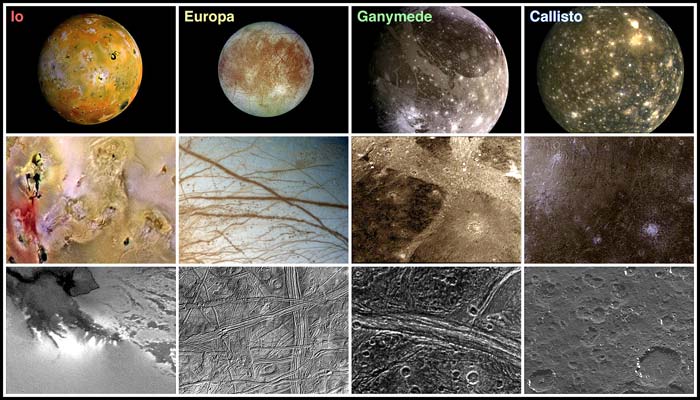
Review Questions
Key Terms
© 2018 Eric H. Christiansen and Braxton Spilker - All rights reserved